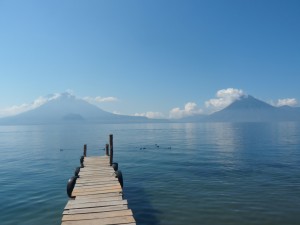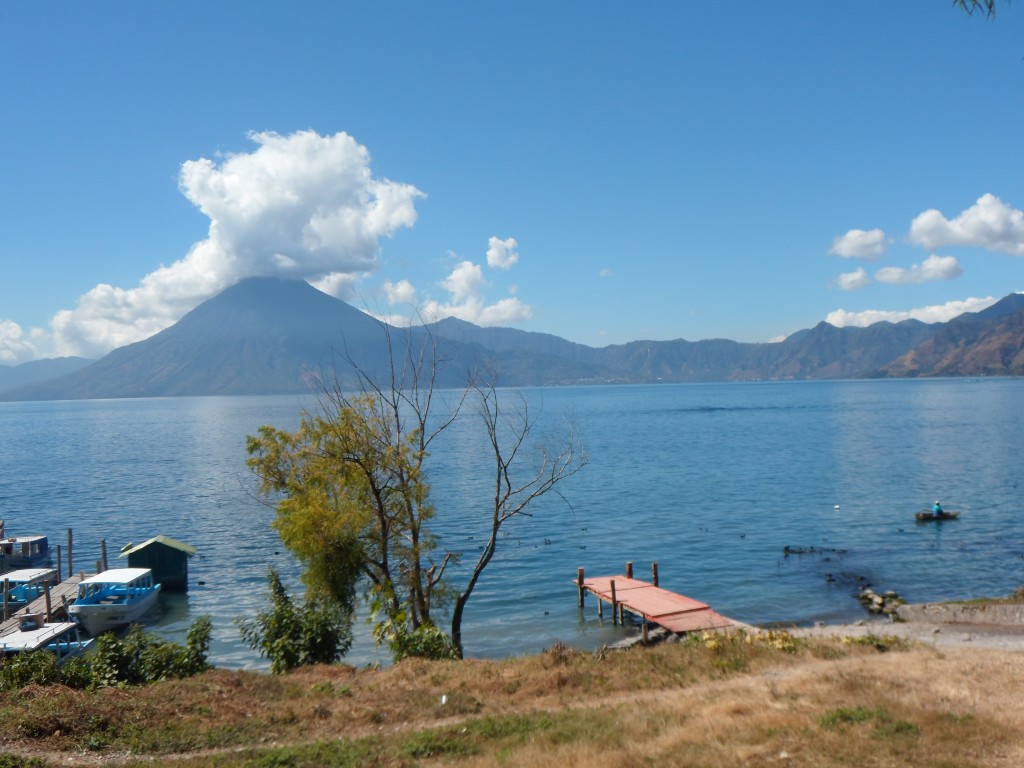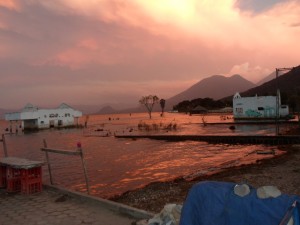Today Joel Gill (GfGD Founding Director) continues his live reporting from Guatemala, whilst undertaking interdisciplinary field research relating to natural hazards and disaster risk reduction. This fieldwork forms part of a NERC/ESRC funded PhD, supervised by staff in the Department of Geography at King’s College London.
Lake Atitlan is a beautiful location, created by a significant volcanic eruption around 85,000 years ago. As large amounts of volcanic material was erupted, the surface load became too great and it collapsed inwards, creating a depression known as a caldera. This depression soon filled with water, and three new volcanoes developed: San Pedro (believed extinct), Toliman (believed dormant) and Atitlan (active/dormant). These processes have created a dynamic and beautiful landscape, creating a location popular with international and Guatemalan tourists today.
As idyllic as the images above look, however, there are a range of environmental hazards currently impacting this region. Guatemala is susceptible to many natural hazards (hence me being here!), including earthquakes, volcanic eruptions, landslides, floods, tropical storms and hurricanes, heat waves, droughts and geotechnical failure. There are though some unusual hazards around Atitlan that are disrupting the lives of local communities.
There is a limited scientific literature on these hazards around Lake Atitlan (with much more work to be done). What I have found very interesting, however, is the amount of information that I have been able to gather through informal interviews with those who have lived there for decades (including the information passed down by their parents and grandparents) and the differences in ideas, reasoning and understanding conveyed. It is the information from these conversations that I’ve noted below and focused this article on. A few simple discussions with people who have observed change around them can enhance the design of research and formation of hypotheses. I’d definitely recommend interested individuals explore what has been written in the published literature to complement the ‘stories’ outlined below:
Rising Waters in Lake Atitlan
The first issue, evident to anybody visiting the area, is the rising water inundating houses close to the shoreline. Through a series of interviews it was suggested that the water has a cyclical rise and fall (with the last high about 50 years ago), and has been doing so for as long as people have a collective memory. This understanding has benefited many of those whose families have lived around the lake for generations, they have chosen to build their properties up the slopes and away from the shore. Many tourists, however, have constructed bars, cafes and hotels close to the lake edge and found out the hard way over the past few years why this is not always a good idea.
What reasons did people put forward as to why this was happening? Although my interviews were not extensive, not once did anybody mention the possibility of it being related to volcanic activity in the area (which the Lonely Planet guide suggests is a ‘more authoritative theory’). Instead opinion centred on two key factors (i) an increase in sediment entering the lake (due to deforestation, landsliding, and agriculture), and (ii) the interaction between the lake water and groundwater. The two theories are indeed linked, with the idea that increased sedimentation blocks the fractures that allow natural drainage out of the lake into groundwater aquifers (the only major output of water). Further evidence of this relationship comes from the significant drop in lake level after the 1976 earthquake, likely due to new fractures opening up facilitating drainage.
(As a side note, it is interesting that the Lonely Planet promotes the volcanic theory as being an authoritative explanation, I’m struggling to find any published material on this theory – so do leave a link to a paper if you come across one!)
Cyanobacterial Blooms
A second significant issue in the region is the relatively recent development of an annual cyanobacterial film across the lake. Those I was interviewing suggested this happened almost always in October (the end of rainy season), and had occurred annually for the past 3-5 years (there is published work suggested an initial bloom was observed in 2008 and a larger one in 2009). They also noted that prior to this, they remember the lake being very clean and not seeing such pollution. In their opinion the bloom was linked with a decrease in fish, as well as negative impacts on human health.
The cause of the bloom was attributed by some interviewees to a sharp increase in motor boats on the lake, with the resulting oil/petrol input generating the bloom. This contrasts with some of the literature that is worth exploring a bit more. Global Nature named Lake Atitlan the ‘most threatened lake of the year’ in 2009 because of the bloom. In their report they note the sudden increase in raw sewage entering the lake after a treatment plan was destroyed during Hurricane Stan. They also note a big problem with litter and uncontrolled waste deposition in the area. Waste leachate, agricultural fertilisers and sewage enter the lake, and promote the development of cyanobacteria through the process of eutrophication. It is interesting to note the much broader, holistic explanation of the blooms (incorporating multiple facets) given by the conservation agencies and academics – in contrast with the ‘single-point’ causes often raised by individuals.
Some Reflections
Interviewing prior to starting research can be a fascinating (at times difficult) thing to do. It often raises more questions than it answers, and it can only ever be part of an investigation into something such as an environmental hazard. It is, however, a very valuable use of time and effort. Through these introductory interviews I learnt information I couldn’t find anywhere else, developed a set of questions to ask other people and had some thoroughly enjoyable discussions centred around applied geoscience that helped to promote sustainability and hazards education.
The example of the cyanobacteria in particular highlights the room for more public education and the limitations of just relying on non-expert interviews, good scientific fieldwork and analysis is also required. However, the latter things are normally our strengths as geologists and the interviewing a rarely practised skill. There is so much to gain from an informal interview process – especially when in a context, setting and culture that is new. It can be a powerful tool for education and understanding, in both directions (researcher-interviewee).



